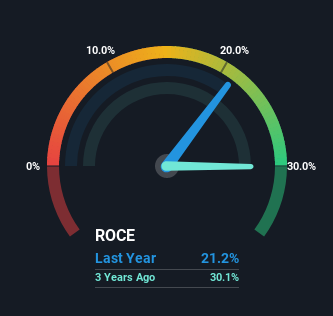- India
- /
- Gas Utilities
- /
- NSEI:ATGL
We Like Adani Total Gas' (NSE:ATGL) Returns And Here's How They're Trending

If we want to find a stock that could multiply over the long term, what are the underlying trends we should look for? Ideally, a business will show two trends; firstly a growing return on capital employed (ROCE) and secondly, an increasing amount of capital employed. If you see this, it typically means it's a company with a great business model and plenty of profitable reinvestment opportunities. So when we looked at the ROCE trend of Adani Total Gas (NSE:ATGL) we really liked what we saw.
What Is Return On Capital Employed (ROCE)?
For those that aren't sure what ROCE is, it measures the amount of pre-tax profits a company can generate from the capital employed in its business. The formula for this calculation on Adani Total Gas is:
Return on Capital Employed = Earnings Before Interest and Tax (EBIT) ÷ (Total Assets - Current Liabilities)
0.21 = ₹7.0b ÷ (₹51b - ₹18b) (Based on the trailing twelve months to December 2022).
Thus, Adani Total Gas has an ROCE of 21%. On its own that's a fantastic return on capital, though it's the same as the Gas Utilities industry average of 21%.
See our latest analysis for Adani Total Gas

Historical performance is a great place to start when researching a stock so above you can see the gauge for Adani Total Gas' ROCE against it's prior returns. If you're interested in investigating Adani Total Gas' past further, check out this free graph of past earnings, revenue and cash flow.
The Trend Of ROCE
Adani Total Gas is displaying some positive trends. The data shows that returns on capital have increased substantially over the last five years to 21%. The company is effectively making more money per dollar of capital used, and it's worth noting that the amount of capital has increased too, by 76%. This can indicate that there's plenty of opportunities to invest capital internally and at ever higher rates, a combination that's common among multi-baggers.
For the record though, there was a noticeable increase in the company's current liabilities over the period, so we would attribute some of the ROCE growth to that. The current liabilities has increased to 35% of total assets, so the business is now more funded by the likes of its suppliers or short-term creditors. Keep an eye out for future increases because when the ratio of current liabilities to total assets gets particularly high, this can introduce some new risks for the business.
In Conclusion...
To sum it up, Adani Total Gas has proven it can reinvest in the business and generate higher returns on that capital employed, which is terrific. Since the stock has returned a staggering 585% to shareholders over the last three years, it looks like investors are recognizing these changes. With that being said, we still think the promising fundamentals mean the company deserves some further due diligence.
Since virtually every company faces some risks, it's worth knowing what they are, and we've spotted 2 warning signs for Adani Total Gas (of which 1 is a bit concerning!) that you should know about.
High returns are a key ingredient to strong performance, so check out our free list ofstocks earning high returns on equity with solid balance sheets.
New: Manage All Your Stock Portfolios in One Place
We've created the ultimate portfolio companion for stock investors, and it's free.
• Connect an unlimited number of Portfolios and see your total in one currency
• Be alerted to new Warning Signs or Risks via email or mobile
• Track the Fair Value of your stocks
Have feedback on this article? Concerned about the content? Get in touch with us directly. Alternatively, email editorial-team (at) simplywallst.com.
This article by Simply Wall St is general in nature. We provide commentary based on historical data and analyst forecasts only using an unbiased methodology and our articles are not intended to be financial advice. It does not constitute a recommendation to buy or sell any stock, and does not take account of your objectives, or your financial situation. We aim to bring you long-term focused analysis driven by fundamental data. Note that our analysis may not factor in the latest price-sensitive company announcements or qualitative material. Simply Wall St has no position in any stocks mentioned.
About NSEI:ATGL
Solid track record with mediocre balance sheet.


